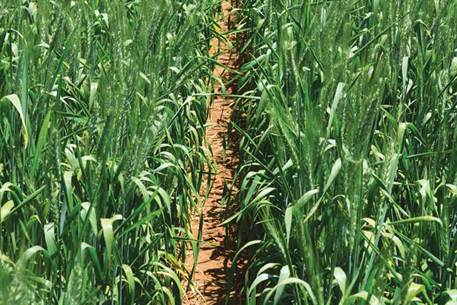Agriculture Needs New partnership structure
Agriculture Needs New partnership structure to fulfill its socio-economic potential, says expert
By Moses Wasamu
 The challenges to achieving global food security are enormous. Experts say that at least 900 million people do not get enough food to eat, global population is expected to increase by 2 billion by 2050 and scientists are battling the threat of climate change, which causes erratic weather patterns and global warming.
The challenges to achieving global food security are enormous. Experts say that at least 900 million people do not get enough food to eat, global population is expected to increase by 2 billion by 2050 and scientists are battling the threat of climate change, which causes erratic weather patterns and global warming.
And all these factors, plus many others, affects the income of farmers and peoples livelihoods.
Gagan Khurana, co-founder at Maxiterra, an agricultural innovation and technology organisation, says that because of rapid development in agriculture planning, solutions which have worked before may not be relevant any more. Therefore, he proposes new partnership structures that will enable agriculture to improve and fulfill its social and economic potential.
In a presentation made in Mexico to mark 50 years of International Maize and Wheat Improvement Center (CIMMYT) work in the world, Gagan said that significant issues exist at every stage of the value chain which hinder progress. Gagan says that subsistence farmers (smallholders) are stuck in a poverty trap preventing them from improving their livelihood.
An analysis of the situation shows that smallholder farmers fall outside the formal supply chain. He adds that it is possible to break this vicious cycle of poverty without subsidies and donor grants, through innovations in the existing supply chain structure.
Whereas cooperatives societies, which are common in most developing economies, have tried to achieve increased incomes for farmers, they have not succeeded in most cases because of lack of capability in managing all aspects of the value chain on a commercial basis, limited education levels which do not allow farmers to develop commercial and business skills, and dependence on government subsidies and political interference.
To reverse the situation, Gagan says, there is need to restructure the value chain in order for the small holder to take a larger part of the profit margin, build small holder capabilities in order to increase the size of the profit margin through better yields and higher quality products, and to involve all stakeholders (government, private companies, NGOs) to identify and address critical non-agriculture related enablers and blockers to smallholder success.
Fortunately, he says, governments, global organizations and farmers are already collaborating with each other to help improve existing agriculture and supply chains through public Private Partnerships (PPPs). He points out that these public and private sector engagements have been the missing link in the agricultural value chain.
Agriculture stakeholders should change their business-as-usual approach.
For these changes to happen, he says, agriculture sector companies and other stakeholders will need to change their businessas- usual approach, in order to take advantages of reduced costs per unit sold due to sharing of distribution channels, and creation of more robust value chains due to increased interaction and integration between the players along the value chains.
Since agriculture supply chains in most emerging markets are not efficient, he says one way to go around this would be to make the value pool distribution more efficient through improved information flows backed by alternate access channels that allow the farmers to earn more money without necessarily increasing factorygate prices.
This can happen by way of the PPPs creating an innovative field model to achieve inclusive growth. He proposes a Special Purpose Entity (SPE) to create and manage integrated valuechains. The purpose of the SPE would be to coordinate the work and output of several actors and companies in the value chain. These actors include input suppliers and distributers, farmers, aggregators, consolidators, the broader market and buyers.
The proposed SPE ownership structure should include farmers, companies and NGOs initially, with farmer associations increasing their stake over a period of time. Gagan says that to make this work, there is a critical need to create practical structures which allow complex PPP arrangements to efficiently and quickly implement projects on the ground.
Other necessary interventions he mentions are in the area of research and development, input distribution and adoption, farming, trading and processing, and in manufacturing and retailing. Cross-cutting issues that can also be addressed include policy environment, infrastructure and market linkages.
Positive results as a result of interventions in Africa Gagan said that a better understanding is required of the optimal tradeoffs between different stakeholder needs and the results that can be achieved. He says that in some countries like Rwanda, Morocco and Ghana, some positive results have been achieved as a result of putting in place some interventions.
Gagan, an expert on agriculture and water, says these interventions have seen maize yields increased two-fold, and agriculture GDP reached 7% per annum in Rwanda; in Morocco, the smallholder income increased from USD 1,000 to USD 3,000, while in Ghana, it led to the vision to increase rice self-sufficiency from 30% to 70%.
Gagan was one of the main speakers in the conference that brought together over 500 scientists, government officials, farmers and members of the international agriculture for development community in a three-day conference.
According to the organisers, the event was a chance to reflect on the past and discuss how the socio-environmental challenges of the future will affect agriculture research for development, smallholder farmers and crop yields.
Gagan has worked extensively in Asia, Latin America and Africa over the last two decades. His work focuses on agriculture, rural supply chains, sustainable use of water and land, economic issues related to rural development and social programmes.
The CIMMYT works throughout the developing world to improve livelihoods and foster more productive, sustainable maize and wheat farming. It targets critical challenges, including food insecurity and malnutrition, climate change and environmental degradation.